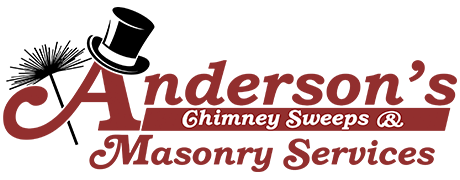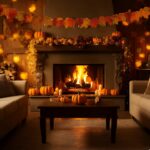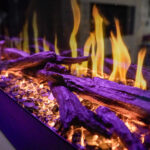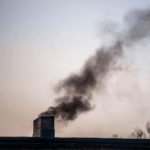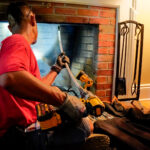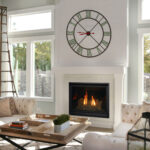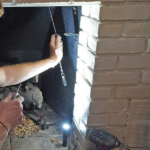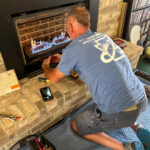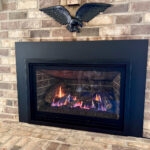Whether you have a new home with a fireplace or you’ve had it for a while, it’s best to know the important stuff about your chimney. The parts of your chimney, the terminology of the parts and pieces, and the science that keeps it working is all valid information to learn today.
The Anatomy of Your Fireplace
From top to bottom, your fireplace most likely has all or most of the following parts:
- Cap – Acting as a roof of the chimney, the flue opening is protected by the cap. The cap has a metal top that keeps precipitation from falling into the flue as well as a metal mesh seal that keeps animals and debris out.
- Crown – When water falls from the cap, it lands on the chimney crown. The crown extends from the flue pipe to the edge of the chimney and extends two inches past the masonry. The best crowns are constructed with the metal mesh within the mortar to maintain a solid construction, at least 4 inches thick at its thinnest part, and a slant and drip edge to shed water away from the flue.
- Flue – The shaft which vents the smoke, particulate pollution, creosote, and gases is called the flue. The flue is on the inside of the masonry chimney structure and reaches from the crown all the way to the smoke chamber below.
- Flue Liner – The flue liner protects the masonry from the hazardous and corrosive materials which travel through the flue. It also keeps toxic gases from escaping the chimney system and affecting the breathable air in the home. The liner also provides a smooth surface for the flue which promotes optimal airflow. This part of the chimney can be made of clay tiles, stainless steel, aluminum, and cerfractory flue sealant materials. These liner types are not all rated for every fuel type, however.
- Chimney – The chimney structure itself is constructed of masonry or may be prefabricated. Masonry chimneys are often in the interior or o an exterior wall of the home. However, prefabricated chimneys are often on the exterior.
- Smoke Chamber – Just above the firebox but below the entrance of the flue there is a space where the smoke mingles with heat so that it will rise up the flue on the draft created by the fire. The smoke chamber features a shelf (called the smoke shelf) that prevents the smoke from falling back into the fireplace where it might push into the home. The chamber itself is shaped like an inverted funneling, directing the smoke up the flue once it’s mixed and heated.
- Damper – A metal plate that closes and opens the flue is called the damper. A throat damper is placed in the space between the firebox and the smoke chamber while a top-seal damper also stops airflow, but doubles as a chimney cap at the top of the chimney.
- Firebox – The firebox is often called the fireplace and is the space where the fire sits and burns. The firebox is constructed of firebricks and refractory mortar that prevents heat transfer from the fire to the house. This is the part of the entire chimney system that endures the most abuse—holding the highest temperatures for the longest time—yet receives the least attention and care.
- Hearth – The floor of your firebox/fireplace is constructed of firebrick and refractory mortar and usually extends 18 inches or more from the fireplace opening. Some hearths feature a large step that extends the entire length of the wall where the fireplace sits.
- Ash Dump – Many masonry fireplaces have an ash dump or ash pit beneath the firebox. It can be accessed by a trapdoor at the back of the firebox where homeowners can easily remove ash by shoveling it into the pit. The ashes can cool in the ash pit and can accumulate for years before filling the space. A chimney sweep can clean the ash pit of ashes by way of a clean-out door found outside the house or in a basement area.
- Foundation – The entire chimney system is extremely heavy and requires a firm foundation of concrete. If your chimney foundation fails it will lead to a leaning or crumbling chimney that can be both dangerous and expensive to repair.
Chimney Science and Need-to-Know
- Prefabricated – A fireplace or chimney that is factory-built and then installed into a home.
- Updraft – A necessary stream of air that moves up the chimney, driving smoke, heat, and particles up the flue and out of the home. An updraft will pull air from the house and through the fireplace, so there may need to be a door or window cracked to allow air into the home.
- Downdraft – A flow of air entering the chimney and moving down into the home. This may occur when the chimney is not being used, during periods of high pressure, and when a chimney is filled with cold air.
- Fuel-type – The sort of fuel your fireplace, insert, or stove burns. Common fuel types include firewood, pellets, gas, and oil.
- Properly Seasoned Firewood – Firewood that has been cut to length, split, and stored for at least six months is dry and safe for burning. Green or freshly cut firewood burns poorly, produces less heat, and creates more byproducts to clog up the chimney system.
- Chimney Sweep – A routine service which is a thorough cleaning of the chimney system from top to bottom in which a certified technician uses brushes and rods to clean away soot and creosote and contains it all in a vacuuming system.
- Chimney Inspection – An annual assessment that determines the safety and efficiency of a chimney system.
So that you can rest assured your fire is safe for the holidays and all year-round.

